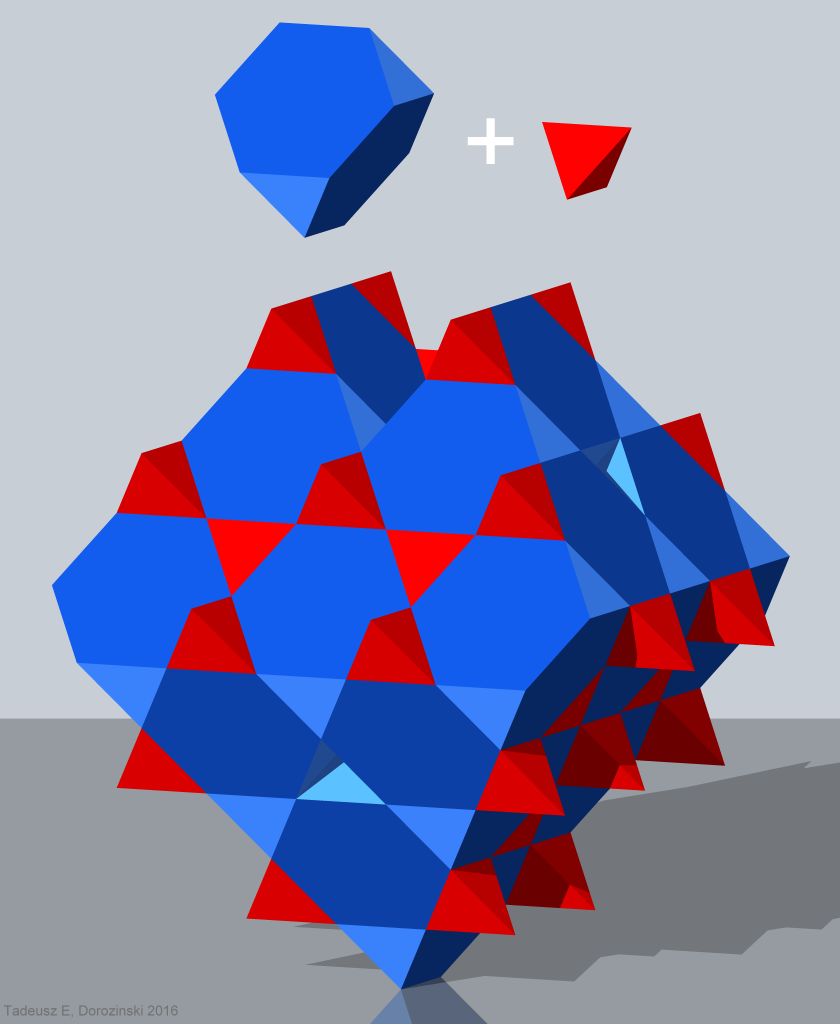Triakis Truncated Tetrahedral Honeycomb on:
[Wikipedia]
[Google]
[Amazon]
The triakis truncated tetrahedral honeycomb is a space-filling

tessellation
A tessellation or tiling is the covering of a surface, often a plane, using one or more geometric shapes, called ''tiles'', with no overlaps and no gaps. In mathematics, tessellation can be generalized to higher dimensions and a variety o ...
(or honeycomb
A honeycomb is a mass of hexagonal prismatic wax cells built by honey bees in their nests to contain their larvae and stores of honey and pollen.
Beekeepers may remove the entire honeycomb to harvest honey. Honey bees consume about of honey ...
) in Euclidean 3-space
Three-dimensional space (also: 3D space, 3-space or, rarely, tri-dimensional space) is a geometric setting in which three values (called ''parameters'') are required to determine the position of an element (i.e., point). This is the informa ...
made up of triakis truncated tetrahedra. It was discovered in 1914.
Voronoi tessellation
It is theVoronoi tessellation Voronoi or Voronoy is a Slavic masculine surname; its feminine counterpart is Voronaya. It may refer to
*Georgy Voronoy (1868–1908), Russian and Ukrainian mathematician
**Voronoi diagram
**Weighted Voronoi diagram
** Voronoi deformation density
** ...
of the carbon
Carbon () is a chemical element with the symbol C and atomic number 6. It is nonmetallic and tetravalent—its atom making four electrons available to form covalent chemical bonds. It belongs to group 14 of the periodic table. Carbon mak ...
atoms in diamond
Diamond is a solid form of the element carbon with its atoms arranged in a crystal structure called diamond cubic. Another solid form of carbon known as graphite is the chemically stable form of carbon at room temperature and pressure, ...
, which lie in the diamond cubic
The diamond cubic crystal structure is a repeating pattern of 8 atoms that certain materials may adopt as they solidify. While the first known example was diamond, other elements in group 14 also adopt this structure, including α-tin, the se ...
crystal structure.
Being composed entirely of triakis truncated tetrahedra, it is cell-transitive
In geometry, a tessellation of dimension (a plane tiling) or higher, or a polytope of dimension (a polyhedron) or higher, is isohedral or face-transitive if all its faces are the same. More specifically, all faces must be not merely congrue ...
.
Relation to quarter cubic honeycomb
It can be seen as the uniformquarter cubic honeycomb
The quarter cubic honeycomb, quarter cubic cellulation or bitruncated alternated cubic honeycomb is a space-filling tessellation (or honeycomb) in Euclidean 3-space. It is composed of tetrahedra and truncated tetrahedra in a ratio of 1:1. It is c ...
where its tetrahedral
In geometry, a tetrahedron (plural: tetrahedra or tetrahedrons), also known as a triangular pyramid, is a polyhedron composed of four triangular faces, six straight edges, and four vertex corners. The tetrahedron is the simplest of all the ...
cells are subdivided by the center point into 4 shorter tetrahedra, and each adjoined to the adjacent truncated tetrahedral cells.
:
See also
*Disphenoid tetrahedral honeycomb
The tetragonal disphenoid tetrahedral honeycomb is a space-filling tessellation (or honeycomb) in Euclidean 3-space made up of identical tetragonal disphenoidal cells. Cells are face-transitive with 4 identical isosceles triangle faces. John Hor ...
References
Honeycombs (geometry) Truncated tilings {{Polychora-stub